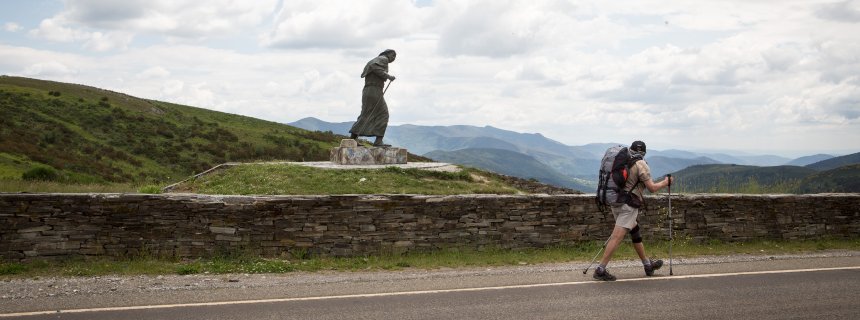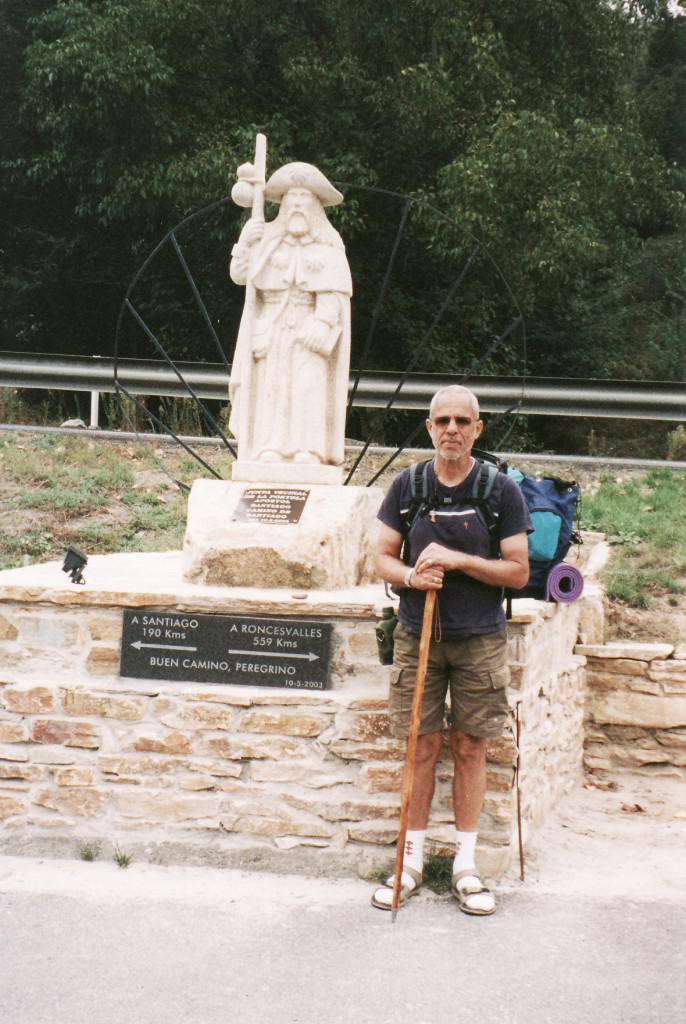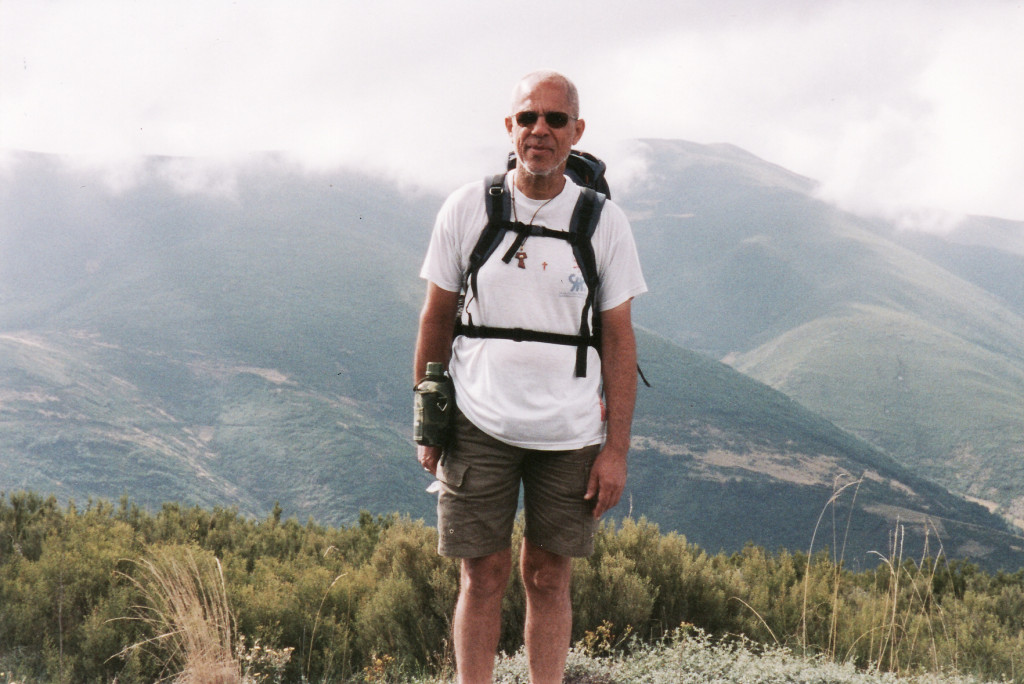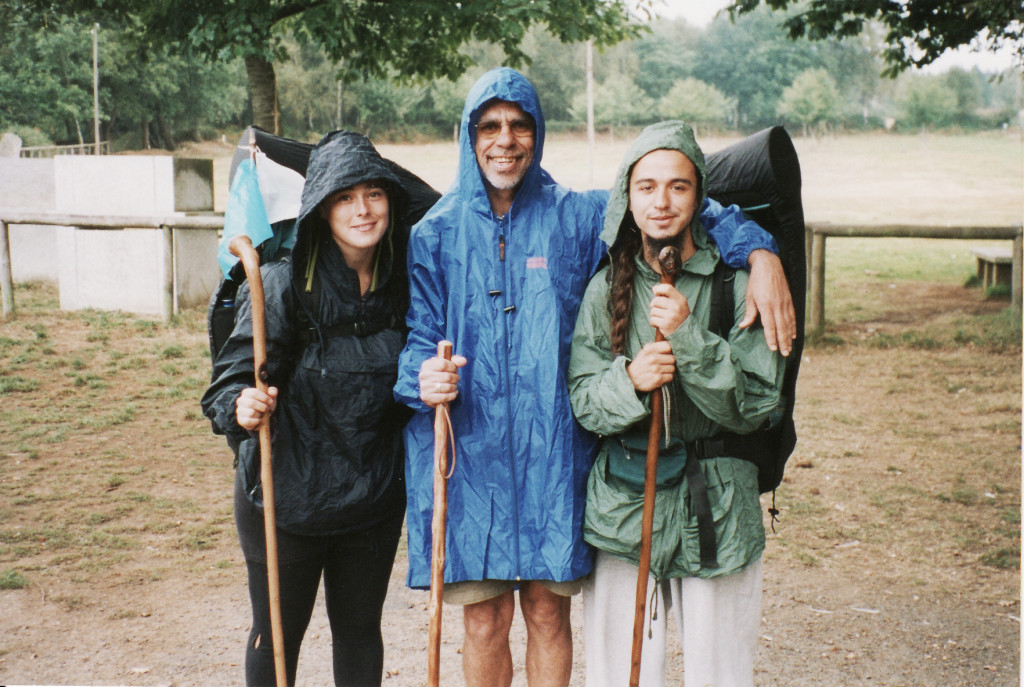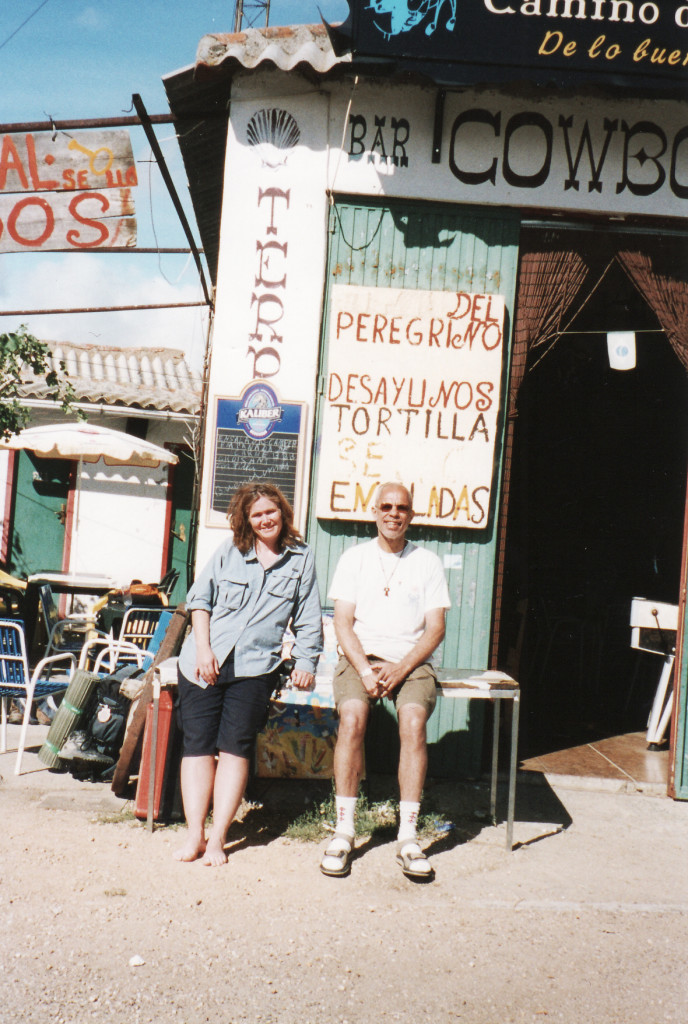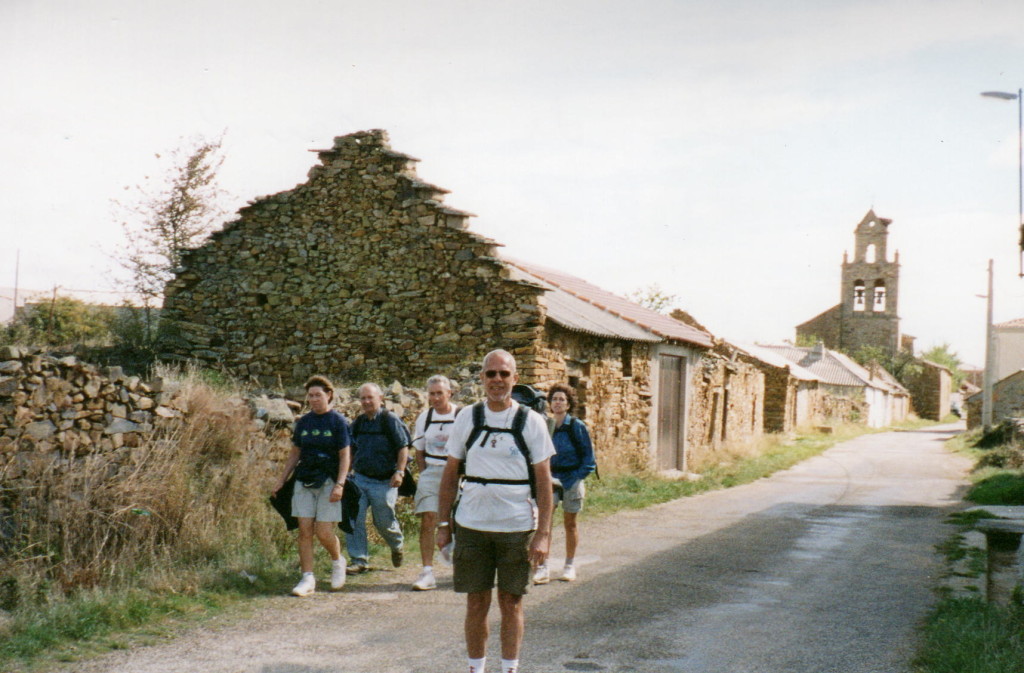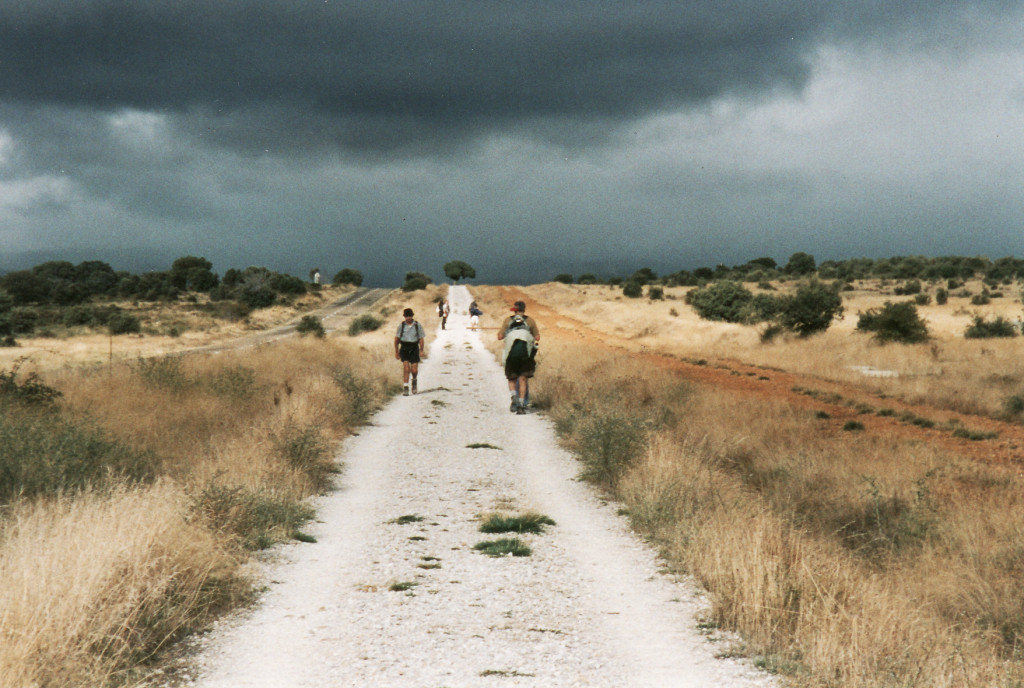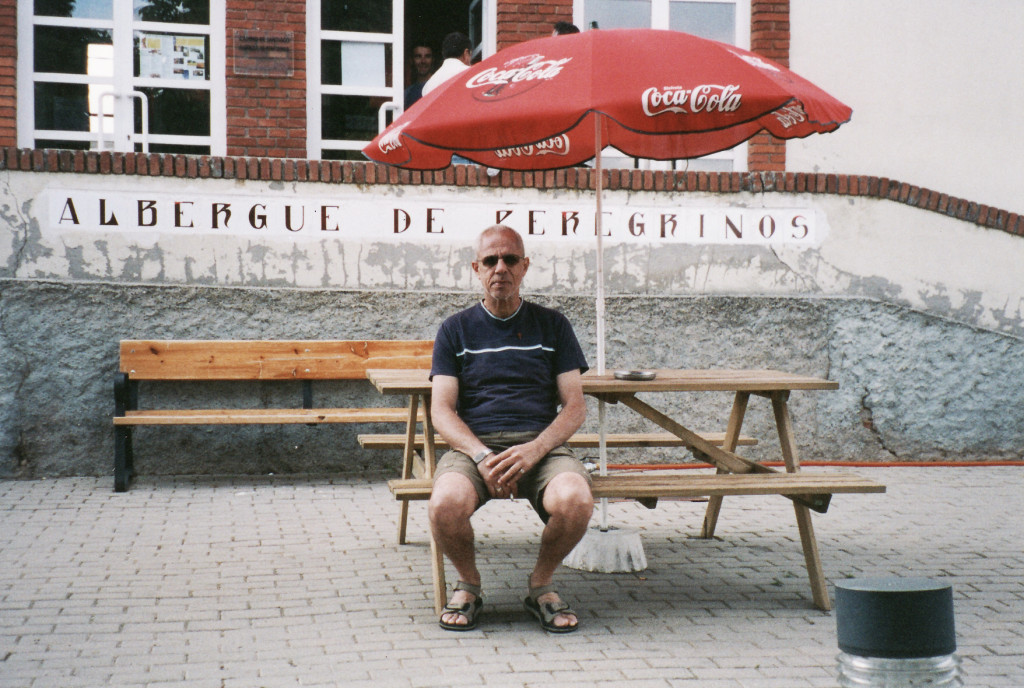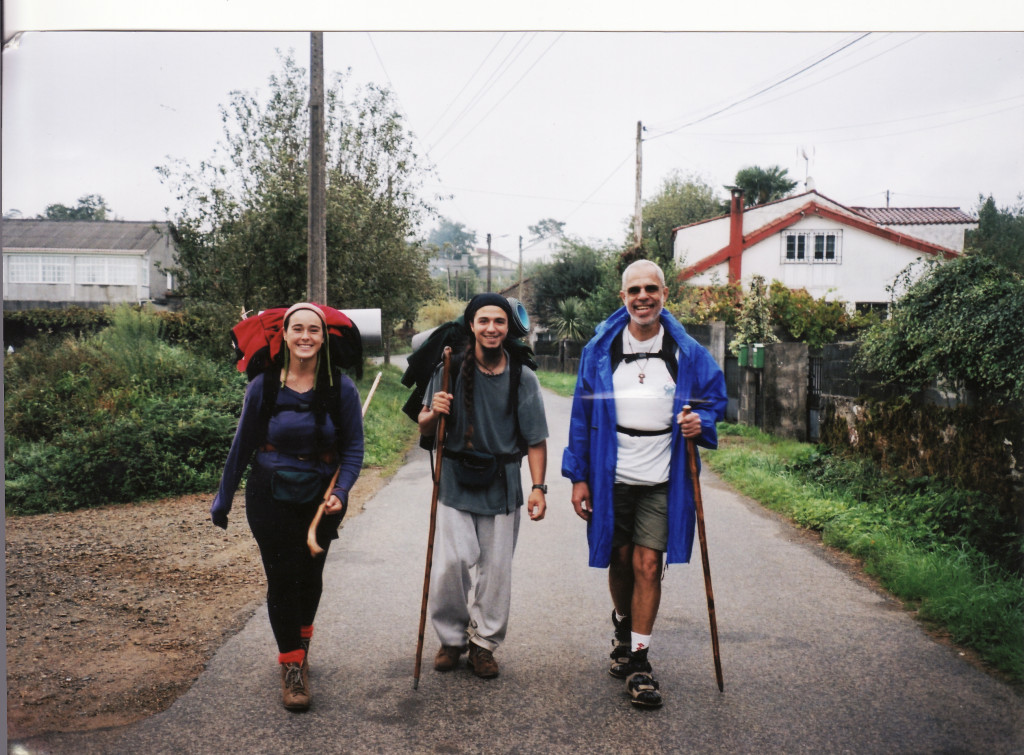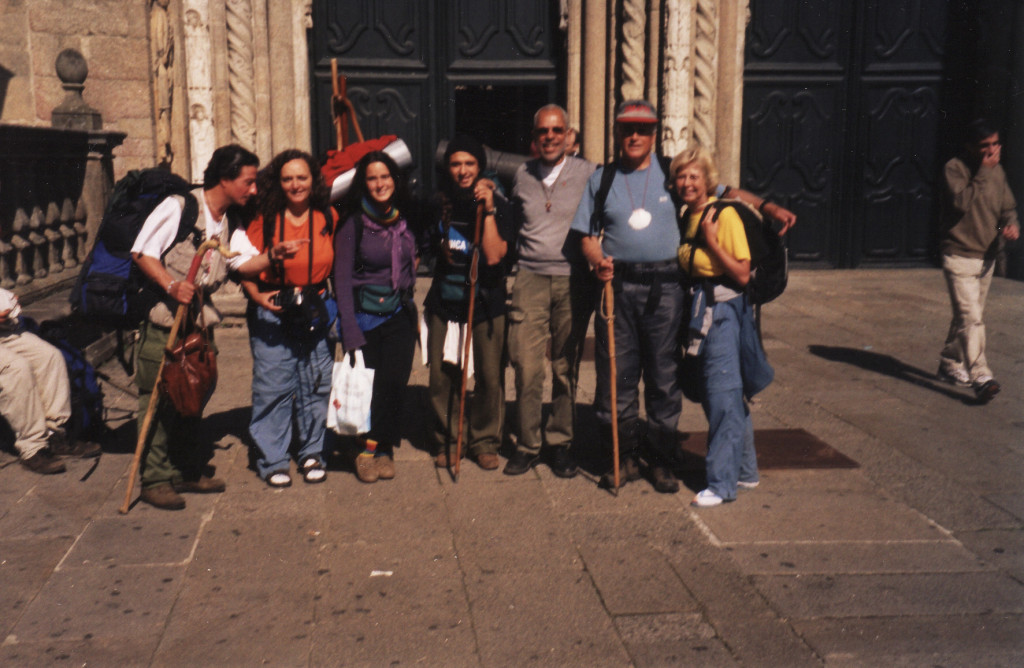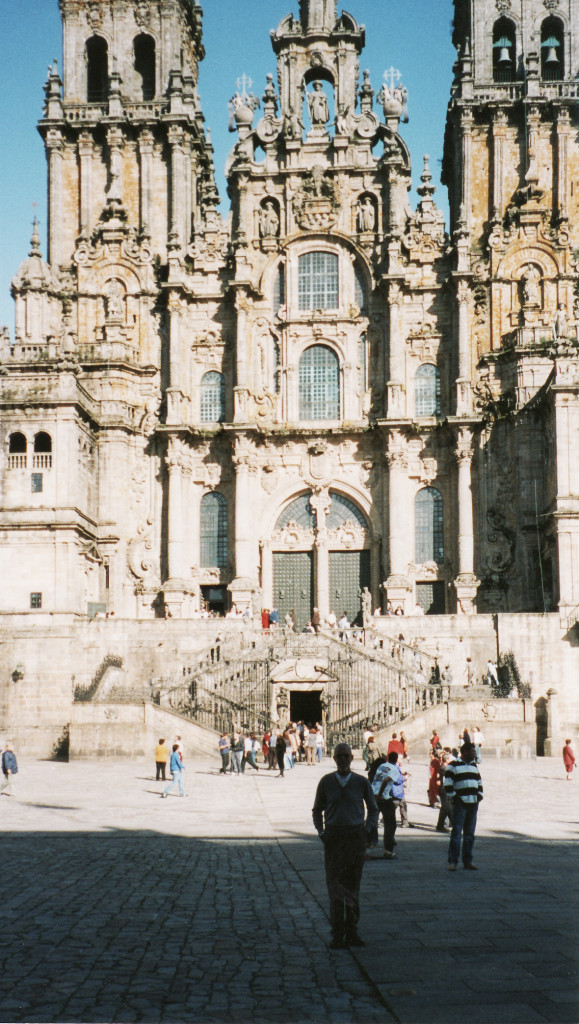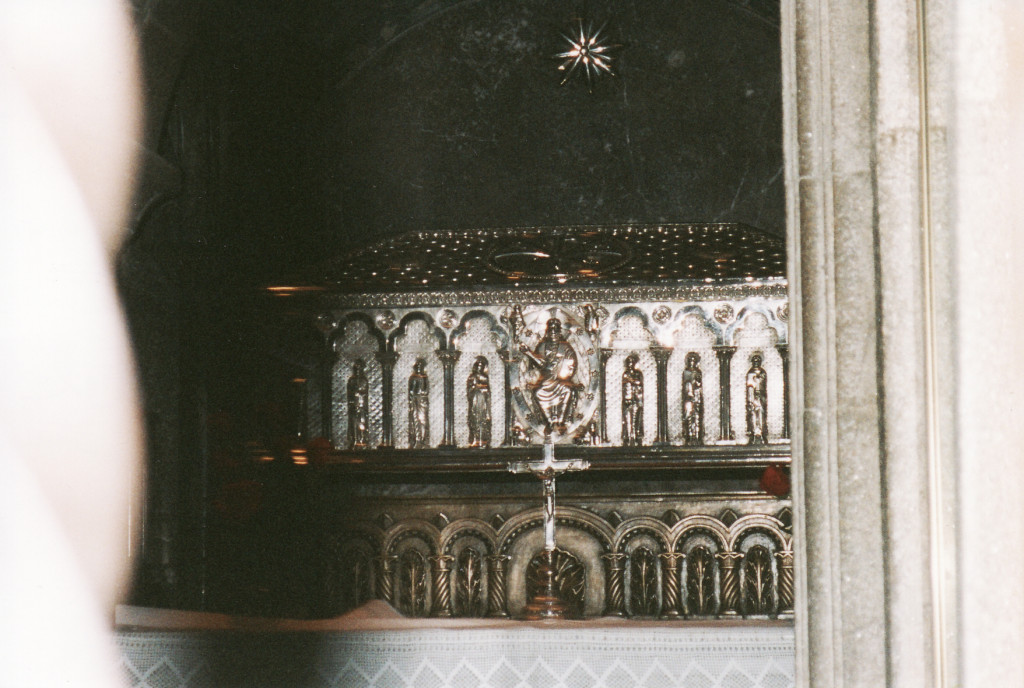Camiño de Santiago: Soul Searching and Commerce on the Way of St. James
SPIRITUALITY, 11 Aug 2014
Juan Moreno on the Camino de Santiago – Der Spiegel
Not long ago, only a few people would make the pilgrimage to Santiago de Compostela in Spain. Now, over 200,000 people a year spend several grueling weeks along the route. Traditionalists turn up their noses at the crowds, but the rewards are still vast.
In the Middle Ages, pilgrimages were neither a quest for meaning, nor an opportunity for contemplation, nor an event. People had real worries and pilgrimages were part of a deal. On the one hand was the willingness of the faithful to suffer, on the other was God’s capacity for deliverance. The one walks, the other heals — a transaction based on reciprocity.
Similar to mendicants, pilgrims had no possessions beyond what they carried with them: a walking stick, a small sack of belongings, a gourd full of drinking water and the clothes on their back. They were filled with reverence and, not uncommonly, a thirst for adventure.
The grave of St. James in Santiago de Compostela has been a pilgrimage site for over 1,000 years. When times were quiet, only a dozen people would make the effort. At other times, it would be a couple of thousand.
But the quiet years are over. More than 200,000 people followed the Way of St. James last year. And this year, those who make money from the steady stream of wayfarers are in a particularly celebratory mood. Four million copies of the book “I’m Off Then: Losing and Finding Myself on the Camino de Santiago” by German TV celebrity Hape Kerkeling have been sold in Germany, and its impact has been huge: Since its publication in German nine years ago, Germans have made up the largest share of foreigners making the pilgrimage. Last year, according to church statistics, 16,000 of them turned up in Santiago, a new record. And now, German public television station ARD is making the movie.
But will that mean that even more people will come? If so, it raises questions about the meaning of the trek — and fears that it could become little more than a traveling circus. There is no doubting the potential economic benefits for one of Spain’s poorest regions, but there are also 1,000 years of tradition to consider.
This is an attempt to find answers to such questions. A search among soul-searchers.
Saint-Jean-Pied-de-Port, 769 kilometers to Santiago de Compostela
Pilgrims should be poor, a requirement that still holds today. They should also clear their minds of worldly concerns. Not all of today’s devotees observe the obligations: the Spanish, Americans and French tend not to. But the Germans do. Pilgrims from Germany see their trip as a chance to free themselves of unwanted ballast, spiritual mostly, but also material. They transform themselves into wandering ascetics who view the Camino as a chance to put their humility on display. Many tend to carry no more than seven or eight kilograms in their backpacks and smile condescendingly at those who lug more. They take their drinking water from village fountains, knowing full well that “no potable” means that it is not safe for consumption. They use their smartphones to look on Camino blogs for the cheapest places to buy white bread.
“I have met pilgrims who have good jobs, yet share a single sandwich among four of them,” says Wim Koelemeijer, a friendly Dutchman who works in the pilgrimage office in Saint-Jean-Pied-de-Port. The town marks the starting point of one of the most common pilgrimage routes, the so-called “camino francés,” which begins in France and has a total distance of 769 kilometers.
Koelemeijer’s office is in the center of town and is visited by pretty much all pilgrims who come through. It is here where they receive their pilgrim IDs, necessary for stays in the hostels along the route. Koelemeijer has been making the pilgrimage regularly for more than 10 years; he is 74 years old.
“You can save everywhere,” Koelemeijer says. “On food, on coffee, on lodging.” The price of spending the night in a hostel? “Four euros.”
But it isn’t stinginess that motivates people to keep their money in their pockets. It’s the principle. Poverty is seen as being equivalent to authenticity. Furthermore, many believe there is a “correct” way to make the pilgrimage and an “incorrect” one. Those who do things correctly begin north of the Pyrenees, travel exclusively by foot and make the entire journey at once, rather than breaking it up into stages that are then completed successively over several years. Real pilgrims walk through northern Spain for four weeks and spend less than €1,000.
And then there are the “real pilgrims” who began making the journey before Kerkeling’s book appeared. They don’t approve of the increase in numbers, saying that back when just a few people were underway, local farmers used to invite travelers in for sausage, wine and a glimpse of a hidden world. They talk of the heart-warming hospitality they experienced along the way and say that the entire trip to Santiago cost almost nothing because the farmers, among the poorest people in Spain, were so generous. Now, they are opening guesthouses with satellite television.
For pre-boom pilgrims, the Camino de Santiago is over. Now, in tiny villages of just 20 residents, there are souvenir shops selling Way of St. James T-shirts, Way of St. James kerchiefs and Way of St. James condoms. Soft drink machines, brightly lit with an image of Santiago’s cathedral, have been set up on the roadside. The farmers who used to invite pilgrims in for a meal are now encouraging their grandchildren — made jobless by Spain’s economic crisis — to open hostels along the way. For many older pilgrims, Kerkeling didn’t just trigger a boom, he launched a pandemic.
It’s now okay for real pilgrims to own Kevlar hiking socks worth €190, an ultra-light sleeping bag for €500, Gore-Tex shoes worth €250 or a geo-caching GPS device for €400. But they often refuse to buy a “café con leche” if it costs the exorbitant sum of €2.20. Pilgrims love yakking about rip-offs along the Way.
In 2013, the average pilgrim on the Way of St. James spent €30 per day with total revenues of businesses along the route adding up to €200 million. That is equivalent to the amount of money spent by tourists in Berlin in a single week. But revenues along the Camino de Santiago are growing, and that is because of the “phony” pilgrims.
Phony pilgrims sleep in guesthouses or hotels and avoid the three-course “pilgrim menu” on offer along the entire journey for €9 to €12, including wine. False pilgrims steer clear of the hostels with their giant sleeping-bag halls housing up to 100 people. They hire taxis to drive their luggage ahead, stage-by-stage, all the way to Santiago. Most aggravating of all for real pilgrims is the fact that a 100 kilometer stroll is the minimum distance necessary to receive a certificate — the same document received by those who walk the hundreds of kilometers from Saint-Jean or even from Munich or Berlin.
Those living along the route, of course, wonder why the real pilgrims even care how the others get their luggage from point A to point B. And ask: Doesn’t God prefer to help unemployed taxi drivers?
Pamplona, 700.5 kilometers to Santiago de Compostela
Six cyclists in brightly colored stretch pants, aged between 50 and 60, are pulling jerseys over their bellies at a traffic circle. They’re Italian, from Rome, and they have a white panel van with them to carry their supplies. And they too are heading for Santiago. Cycling is also considered a legitimate form of making the pilgrimage, with a minimum distance of 200 kilometers necessary to qualify. When asked about the group’s motivation for making the trip, Pietro, the group’s leader, gives a response that almost seems rehearsed. As if for effect, an Italian flag begins flapping in a sudden gust of wind. They are really sad, he says, to only have a week available for the trip to St. James’ grave. And then, as though it was a spontaneous thought, he says that will change in the future. It’s good to slow down, he says, to have time for reflection. Piano, pianino.
“Next time, we are going to start in Rome,” he says.
For the trip to Santiago?
“No, to Auschwitz,” Pietro counters.
People who are actually active in the church are in the minority on the Way of St. James. People like Pietro certainly aren’t. These days, you meet all sorts along the Camino de Santiago: Christians, Muslims, Buddhists, athletes, young people, old people, fat people and freaks. There are single parents with children, babies in strollers and Bible groups on rented mules. There are people who make the journey barefoot, people who are barefoot and walk backwards and people who set off in wheelchairs with respirators. There are also a surprising number who know that they will die along the way. The route is lined with crosses.
Last year, 215,000 people picked up their certificate of completion, known as the “compostela” and issued by the church in Santiago. There were likely more — not everybody has the patience to wait in the long line in front of the pilgrimage office near the cathedral. But the official total was nevertheless a record for a non-holy year. If July 25, St. James’ name day, falls on a Sunday, a holy year at Santiago de Compostela is declared. The last time that happened was in 2010 and 270,000 pilgrims turned up. The next holy year will be in 2021 and Spanish politicians have already asked if perhaps an extra holy year could be declared before then.
By contrast, only 13 pilgrims made the journey in 1978.
Everyone who comes is looking for solace, quiet, freedom and time. After just a couple of days on the Way of St. James, it seems that most of humanity see their everyday lives as a theft of their personal time.
Finding Peace
Wine Fountain of Irache, 649 kilometers to Santiago de Compostela
The hope is that, by the end of the trek, one will have forgotten the reason for starting it in the first place. The daily pilgrimage routine is helpful in this regard. There are the fitful nights in the pilgrim hostels because there is always, without fail, someone who snores like a chainsaw — surprisingly often it is a woman who will deny it the next morning more vehemently than any man. As a rule, people get up at 6 a.m., pack their backpacks and head off in the dark. Sometimes, a café has already opened its doors, but just as often four or five kilometers must be covered before the first coffee. The beginning is often the hardest part, but after a few weeks, the stages become physically less challenging.
The stages tend to be between 20 and 30 kilometers long, a hike that is usually finished by the early afternoon. The rest of the day is filled with securing a spot in a hostel, taking care of blisters, showering, doing laundry, resting and wandering around town. Sometimes, there is a mass to attend and in the evening, there is time to chat with the other pilgrims one has met along the way. Dinner comes early and at 10 p.m., it’s lights out at the hostels.
Life becomes less complex. One begins to relax and become more at peace — and one begins to see more. Attractive fellow pilgrims, for example.
Hundreds of books and stories have been written about the Way of St. James, and yet it remains something of a secret that a not inconsiderable part of its appeal is that a pilgrimage is a perfect opportunity to look for a partner. Many people making the journey are divorced or otherwise single, and many have simply been unlucky in love. The young ones go in the springtime, the older ones in the fall. The whole thing is reminiscent of the InterRailing phenomenon of the 1980s. The mood is free and easy, everyone is sharing an experience, everyone feels like-minded. Conversations start easily, and all begin the same way: “Where are you from?” And then, after a rioja or two: “So, why are you here?”
Along the Camino, not even the greatest misanthropes can avoid coming into contact with others. Serious, deep discussions are commonplace, even if they start with a question about the best treatment for blisters. The pilgrimage is strenuous, which makes people vulnerable and, as a consequence, congenial. Pheromones, a sense of physical well-being stemming from significant weight loss, and a period of forced abstinence take care of the rest. Success is certainly not guaranteed, but it is said that the best thing about sexual adventure is the build-up. And along the Way of St. James, the build-up is 769 kilometers long.
Prototypical in this regard are Gibrael Rowshanzamir from Sweden and Monika Szabo of Hungary.
He is an exceptionally handsome 30-year-old who isn’t just heading for Santiago. He is heading for a problem. And that is because of Monika, a beautiful, svelte 29-year-old with a smile that could melt iron. The two of them have spent the last several days walking together, they say, “because they have the same pace.”
They have just reached the famous wine fountain of Irache. The large winery lies on the Way of St. James in Ayegui, in the Navarra province. And in 1991, they built a large fountain of stone blocks directly on the side of the path. The inscription reads, roughly: “We invite you to drink without getting smashed; but to take some wine with you, you’ll have to leave us some cash.” Allegedly, pilgrims consume 70 liters of the stuff each day. A machine across from the fountain sells small souvenir glasses for one euro.
Great weather, a beautiful Hungarian woman and free wine. The problem? He wants to become a priest. He is a theology student and has already spent time in a monastery in Germany. He’s journeying along the Camino in pursuit of “definitive clarity.”
The lovely Hungarian drinks from the wine — not bad, just a bit warm — and rolls her Bambi eyes. She just broke up with her boyfriend back home. “Do you want to get me drunk?” she asks with a smile. He leans his head on his walking stick. Perhaps he is asking himself why this enchanting Hungarian was sent to him. There are, after all, huge numbers of fat Italians along the Way as well. One thing seems clear: If there is a God, he has a sense of humor. The Hungarian seems determined to take on the entire Roman Catholic Church in a fight for Gibrael. And God has given her all the weapons she might need.
Rabanal del camino, 229.5 kilometers to Santiago de Compostela
The first rule of commerce on the Way of St. James is that anyone wanting to make money — and there is indeed a lot to be made here — must locate their business on the path. Not near the path; not around the corner. Directly on it. Pilgrims detest detours. Just because someone is prepared to hike through northern Spain for four weeks doesn’t mean he or she will take even one extra step to buy a postcard. Location is everything. The pilgrim’s dearest wish, it seems, is to find the next hostel right at the village entrance.
The idyllic, clean-swept mountain village of Rabanal del camino has included the pilgrim trail as part of its name, perhaps out of gratitude. The village is located 1,000 meters above sea level in the middle of forested terrain. It’s barren and rugged, but also beautiful. The setting couldn’t be more perfect.
“Every single euro earned here comes from the pilgrims,” says Father Javier, a friendly, humorous and soft-spoken man. He’s a Missionary Benedictine sent by the Archabbey of Sankt Ottilien near Munich to provide spiritual guidance to pilgrims in Rabanal.
When the Way of St. James boom began in the mid-1990s, the Benedictines decided to build a cloister here. Father Javier and his friar, Father Pius, a man from Chiemgau in Bavaria, regularly attend to the travelers. A few interludes aside, Father Javier has been here since the cloister’s opening. He remembers how it was at the beginning, when only one family lived here, the village didn’t have enough water and no reliable electricity.
The Camino didn’t just change Rabanal, Father Javier says, it saved the village from extinction.
“I don’t think people would still be living in Rabanal if it weren’t for the Way of St. James. The first hostels opened after the pilgrims started coming and restaurants and shops started to pop up later.
Today, Rabanal has 33 residents and provides employment to even more. There are several inns, a rustic hotel, five shops and a handful of restaurants, including an Italian eatery. The village has accommodations for 400 people.
“There are people in this village who used to be able to buy an Audi every year,” Father Javier says.
The situation, though, has changed, he says, and competition is growing. “Young Spaniards aren’t coming anymore because they’ve been swallowed up by the crisis, but foreigners are coming instead,” explains Father Javier. “People are earning less because there’s more on offer. People have to share the revenues. Now it takes two years before they can afford the next Audi.”
Father Javier isn’t too worried about business. Even with 400 pilgrims a day, it’s not as if the village is overflowing with guests. The final 100 kilometers of the Way of St. James, with its hordes of “phony” pilgrims, is different. But for most of the route, it’s not a problem: Four hundred people spread out over 30 kilometers isn’t much.
It’s another issue that troubles Father Javier. The younger generation, who isn’t so much bothered about the two weeks of walking still to go but about worsening mobile phone reception. But no one need worry. “Fifteen years ago, the hostels had signs reading: ‘Warm water here.’ Today, they read ‘Free WLAN.’ Everyone knows that if you don’t provide Internet access, the pilgrims won’t come.”
Father Javier is 44 years old, he owns an iPhone and is in no way dogmatic. With one exception: He will not allow WLAN in his cloister. But for many pilgrims, being offline is a scarier thought than having sing along to Latin Vespers each day.
Most probably, he has simply tired of that most typical of pilgrim scenarios: When break-time comes, the first thing people do is reach for their smartphone to check emails, Facebook and the news. Even if they are standing in front of breathtaking vistas of the grand Castile Meseta plateau, Toni Kroos leaving FC Bayern Munich for Real Madrid seems more important.
The Internet has changed the character of the pilgrimages more than any souvenir shop. Leaving the real world behind takes considerable courage, turning one’s back on the virtual world is more than many can handle. Some don’t even notice how much of their time on Way of St. James is spent writing emails to people back home.
Palas de Rei, 62 kilometers to Santiago de Compostela
Americans always have the best stories to tell, and that’s also true here on the Camino. Justin Skeesuck and Patrick Gray have been friends since childhood. They come from Idaho and served as each other’s best man. Skeesuck is less than a day older than Gray, but it gave him all the excuse he needed to introduce himself to girls as the older and wiser one.
As a fun-loving 16-year-old, Skeesuck was in a car accident that almost killed him. He had to learn how to do everything again — standing up, getting dressed, writing and drawing. But he never gave up: He became a graphic designer and got married. But his illness hasn’t given up either.
Years after his accident, doctors told Skeesuck that it must have triggered a rare auto-immune disorder that progresses extremely slowly. The illness is slowly consuming him, paralyzing one part of his body after the other. At some point he was no longer able to draw and he eventually couldn’t walk anymore. It is only with great effort that he can slightly raise his tensed-up hand. It will almost certainly kill him, likely sooner rather than later.
In the spring of 2012, when he was still able to use a remote control, Skeesuck was channel surfing when he stumbled across a program about the Way of St. James. The narrator said that many pilgrims claim they heard the Camino calling them.
He called Patrick, who also happens to be his neighbor, and Patrick listened intently as Justin talked about the 500-mile journey by foot on largely unpaved trails through northern Spain, the Pyrenees — a real pilgrimage. Patrick’s answer is the title of the documentary currently being made of the two as they make way across the mountains.
“I’ll push you.”
It’s hard not to tear up when you encounter Skeesuck and Gray on the Camino. Skeesuck, a wonderful, quiet storyteller, sitting in his heavy wheelchair; Gray, an athletic man with short gray hair, pushing his friend. Together, Skeesuck and his wheelchair weigh 250 pounds.
On rainy days, which every pilgrim has to deal with at some point on the trail, the wheelchair kept sinking into the mud. Gray would throw his friend over his shoulder and push the empty wheelchair. After bending forward for four weeks, he has developed chronic calf cramps. He has developed muscles in the most unlikely places on his chest.
“The best time of our lives,” the two say. In two days, they will reach the cathedral in Santiago, where their wives will be waiting for them. They’ll likely be joined by other people they have met on the pilgrimage as well.
“Just before the last steep ascent outside of Galicia, 17 pilgrims from 10 different countries were waiting for us. They knew that I wouldn’t be able to do it without their help,” Justin says. Over and over, he says how amazing it was.
They are of course sticking to the narrative laid out by the documentary film director who’s traveling with them: Theirs is a story about friendship, about how limits are to be challenged rather than accepted.
And yet, the more time you spend with them, the more convinced you become that they are truly surprised that they are close to completing the journey. And that they are proud of themselves — and astounded that other pilgrims have abandoned their own schedules just to make sure Justin Skeesuck, in his wheelchair, makes it to Santiago. Both are now convinced that the Camino called to them.
Santiago de Compostela
So what’s the secret? Why do so many people repeat the journey? Why do they all complain about how commercial it has become and yet would do it all again given the chance? Perhaps because the Catholic Church, with its more than 2,000 years of experience in missionary work, has set up a path that perfectly serves spiritual needs. Those who are searching for answers to the deepest of questions can enjoy easily accessible services in magnificent cathedrals, sermons that are always kept short and offered in several languages, and moving Gregorian chants in 12th century Romanesque chapels.
But Mathias Müller, an engineer with BMW in Munich who began his journey at home and arrived at his destination exactly 100 days later, is doubtful that it’s all down to the Camino itself. “It’s about the time that people take for themselves,” he says. “It even changes a person like me.” He means driven, restless types who take their jobs more seriously than anything else and allow themselves to be robbed of their time. “Want the truth? I also could have walked to Moscow,” he says. Ultimately, he chose the Way of St. James because of its ideal infrastructure. He says you have to get used to the fact that you can’t make a reservation at the hostels, but that it always works out in the end. That didn’t come easy to Müller, who even prepared an Excel spreadsheet with the precise timing of his overnight stays, telephone contacts and directions. At some point after crossing the Spanish border, he threw it all away. What he learned from the Camino is that he can get by even without Excel lists or a smartphone.
Müller is now sitting a few hundred meters as the crow flies from the Way of St. James in the hotel bar of the Paradors de Santiago de Compostela, the most expensive place in the city to drink a bottle of Rioja wine. It’s just after 11 p.m. and Müller is exhausted. It’s the longest he’s been awake on any day for the past three weeks. He wears a blue fleece jacket, but he’s still feeling chilly because he doesn’t have a single gram of body fat left. He says the trip has changed him and, if he could, he’d keep walking. People who have undergone a similar experience call it the pilgrim’s death. It comes at the end of the trip and the recognition that the journey was far more important than the person initially thought it would be.
It happens to almost everyone who makes the pilgrimage. In fact, it’s nearly impossible to find anyone who says it wasn’t worth it.
Of course Müller noticed how commercial it has become, particularly during the last hundred kilometers. Like most others, though, he says he was too excited to let it bother him. And while he was eager to reach his destination, he also had some trepidation about the idea of having to read 150 emails back home each day. He says the trip taught him that things are almost never as important as we like to think they are — particularly not when they arrive by email.
Müller is convinced that the growing number of pilgrims on the Camino won’t destroy it — for the same reason that commercialization hasn’t destroyed snow skiing. The product is simply too good.
As long as we live in a world that is too fast-paced, the Camino will retain its attraction; as long as the Way of St. James continues to offer a place where people can walk and communicate the way they should, face to face. The world we live in today is one that creates desires. And with his book, Hape Kerkeling has turned consumers into pilgrims. The Way of St. James takes these pilgrims and turns them into disciples.
__________________________________
Photos: TMS editor Antonio C. S. Rosa 2003 Camino de Santiago pilgrimage.
DISCLAIMER: The statements, views and opinions expressed in pieces republished here are solely those of the authors and do not necessarily represent those of TMS. In accordance with title 17 U.S.C. section 107, this material is distributed without profit to those who have expressed a prior interest in receiving the included information for research and educational purposes. TMS has no affiliation whatsoever with the originator of this article nor is TMS endorsed or sponsored by the originator. “GO TO ORIGINAL” links are provided as a convenience to our readers and allow for verification of authenticity. However, as originating pages are often updated by their originating host sites, the versions posted may not match the versions our readers view when clicking the “GO TO ORIGINAL” links. This site contains copyrighted material the use of which has not always been specifically authorized by the copyright owner. We are making such material available in our efforts to advance understanding of environmental, political, human rights, economic, democracy, scientific, and social justice issues, etc. We believe this constitutes a ‘fair use’ of any such copyrighted material as provided for in section 107 of the US Copyright Law. In accordance with Title 17 U.S.C. Section 107, the material on this site is distributed without profit to those who have expressed a prior interest in receiving the included information for research and educational purposes. For more information go to: http://www.law.cornell.edu/uscode/17/107.shtml. If you wish to use copyrighted material from this site for purposes of your own that go beyond ‘fair use’, you must obtain permission from the copyright owner.
